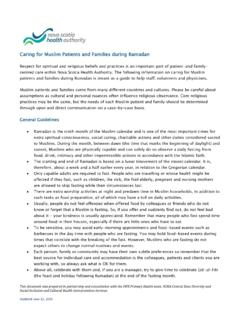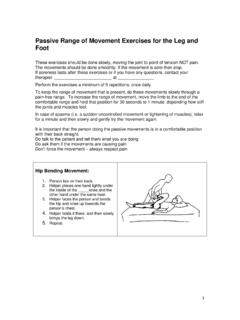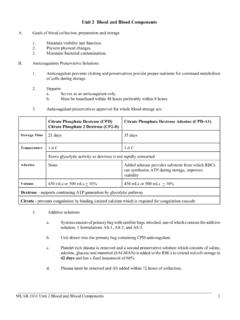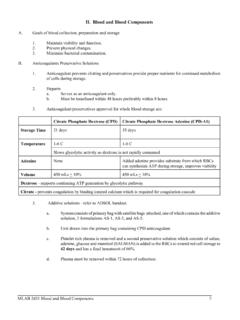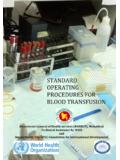Transcription of A Patient’s Guide to Blood Components and Products
1 2014A Patient s Guide to Blood Components and ProductsContentsWhat is a Blood transfusion ? 1 Informed consent 1 Frequently asked questions about Blood transfusions 2 What can I expect during the transfusion ? 2 How do I know if I am having a reaction? 3 After the transfusion 4 Blood Components 5 Red Blood cells 6 RBC transfusion risks 7 Fresh frozen plasma 8 Platelets 9 Cryoprecipitate 10 Blood Products 11 Plasma-derived medications 11 Albumin 11 Octaplex 12 Intravenous immune globulin 13Rh immune globulin 13 Clotting factors 14 Recombinant medications 141A Patient s Guide to Blood Components and
2 Products What is a Blood transfusion ?A Blood transfusion is donated Blood given to patients with abnormal Blood levels The patient may have abnormal Blood levels because of Blood loss from trauma or surgery, or as a result of certain medical problems Whole Blood is separated into its parts or Components (plasma and cells) and Products (the plasma part is sent to a drug manufacturer to be made into Products ) shortly after it is collected from donors at Canadian Blood Services This way, you only get what you need! When people talk about Blood transfusions , they mean transfusions of red Blood cells However, red Blood cells (RBC s) are only 40% of what is in Blood The rest is white cells, plasma, and platelets Informed consentIf your doctor or nurse practitioner (NP) prescribes a Blood transfusion of either Blood Components or Products for you, he or she will explain the benefits and risks of the transfusion and ask you to sign a consent form for the treatment These risks and benefits are different depending on what component or product you need, and on your illness or condition If you have any questions or there is anything that you don t understand, you should ask your doctor or NP before you sign the consent asked questions about Blood transfusionsYou may need a transfusion for many reasons such as to.
3 Increase red Blood cells, so more oxygen circulates in your Blood to support body functions Replace clotting factor or platelets in your Blood to help stop bleeding Replace Blood loss because of trauma or injury Replace Blood loss because of a treatment or procedure that may make your Blood cells lower for a time What can I expect during the transfusion ?The nurse will check your Blood pressure, pulse, and temperature before the transfusion is started The Blood will be given through your intravenous (IV) Two nurses will check the Blood at your bedside before starting the transfusion A nurse will check your Blood pressure, pulse, and temperature after the transfusion has been running for 15 minutes and again when the transfusion is done Your transfusion will take about 1-3 hours It may take a little longer, or it may even take less time depending on what product or component (part) of Blood you are getting 3 How do I know if I am having a reaction?
4 A reaction can happen during a transfusion , up to a day following the transfusion , or even up to several months after the transfusion Your nurse will watch you closely for a reaction If a reaction happens, the transfusion will be stopped During your transfusion , let your nurse know right away if you have any of the following symptoms: Bleeding, pain, or new bruising at the IV site Severe back pain Fever and/or chills Nausea and/or vomiting Rash, hives, itching Headache, dizziness Cold, clammy skin Chest pain Fast heartbeat Trouble breathing, wheezing Dark or reddish urine Yellowing of the skin or eyes4 After the transfusionIf any of the listed symptoms develop after a Blood transfusion , you may be having a transfusion reaction If you are in the hospital, tell your nurse or doctor immediately If you have been discharged from the hospital and any of the above symptoms develop, contact your doctor immediately If you can t reach your doctor, call 911, or go to the nearest Emergency Department After your transfusion , you should rest and take care not to overexert yourself for at least 24-48 hours (1-2 days)
5 Once you are discharged from the hospital, call to schedule a follow-up appointment with your family doctor 5 Blood Components RBC s Platelets Plasma CryoprecipitateDoses of RBC s, plasma, and platelets for transfusion are packaged in special bags made of polyvinyl chloride (PVC) Each dose is called a unit RBC, plasma, and platelet transfusions are given through an IV tube in your arm 6 Red Blood cellsRed Blood cells (RBC s) are the main way that oxygen is carried and sent to the different parts of your body The Blood cells have a molecule called hemoglobin that sticks to oxygen and carries it to all parts of your body If you get packed RBC , you are getting RBC that someone else has donated Your Blood type is tested and you are given Blood from someone who matches your Blood type How are RBCs given?You will get the Blood cells through a tube in your arm, where they will go directly into your own Blood You can get RBC before, during, or after your surgery, depending on what your body needs What are the benefits?
6 The transfusion (the transfer of donated Blood from one person to another) of RBC is used to prevent a condition called anemia Anemia is when you have lower than normal levels of RBC or hemoglobin This makes it harder to send enough oxygen to get to all parts of your body Transfusions also replace Blood lost if too much bleeding has happened By getting RBC transfusions you are less likely to get anemia This will make sure that enough oxygen gets to all parts of your body 7 RBC transfusion risksWhat are the risks or side effects?Possible side effects Hives (1 in 100) Fever (1 in 300) Heart failure (1 in 700)Less likely side effects Lung injury (1 in 10,000) Delayed breaking down of your red Blood cells (1 in 7000)Rare side effects Getting the wrong Blood type (1 in 38,000) Having a severe allergic reaction (1 in 40,000) Bacterial infection (1 in 50,000) Death from bacterial infection (1 in 500,000) Getting hepatitis B (1 in 153,000) Getting hepatitis C (1 in 2,300,000) Getting West Nile virus (less than 1 in 1,000,000) Getting HIV (1 in 7,800,000)Source: Callum et al (2011) Bloody easy 3.
7 Blood transfusion , Blood alternatives and transfusion reactions, 3rd ed ORBCON 8 Fresh frozen plasmaPlasma is the liquid part of your Blood It is called frozen plasma because it was frozen within 24 hours of collection It can be stored this way for up to 1 year Plasma contains water, proteins, and electrolytes Some of the proteins in your plasma help your Blood form clots Plasma is also important for sending many things such as oxygen and glucose ( Blood sugar) to all the parts of your body How is plasma given?If you need plasma, it will be given to you through a tube that goes directly into your Blood What are the benefits?Plasma is used to replace the proteins that help your Blood clot if they are not working or have been destroyed This will help you avoid bleeding and losing a lot of Blood What are the risks or side effects?The risks of getting a plasma transfusion are the same as the risks for getting a packed RBC transfusion Hypothermia (a drop in body temperature) and other metabolic (energy-generating) problems may also happen if large amounts of plasma are used 9 PlateletsPlatelets are a type of Blood cell They are involved in making Blood clots If you do not have enough platelets or the platelets do not work well, there is a risk of too much bleeding How are platelets given?
8 Platelets are given the same way as other Blood transfusions They are given through a tube that goes directly into your Blood What are the benefits?The additional platelets will help you make better Blood clots This lets you avoid too much bleeding What are the risks or side effects?The risks of getting a transfusion of platelets are the same as the risks with the transfusion of RBC See page 7 for more info The risk of fever, bacterial infection, and lung injury are higher with the transfusion of platelets 10 CryoprecipitateCryoprecipitate ( cry-o-pre-sip-i-tate ) is made by warming frozen plasma It has important proteins that help make Blood clots It is made by mixing frozen plasma from several donors How is it given?Like other Blood Products , cryoprecipitate is transfused into your body It is given to you through a tube that runs directly into your Blood What are the benefits?It is helpful if you are bleeding a lot or have small amounts of fibrinogen ( Blood clotting protein) in your Blood It is also helpful if you have a Blood clotting disorder, low levels of clotting factors, or your clotting factors are not working properly What are the risks or side effects?
9 The risks of cryoprecipitate transfusions are the same as the risks of RBC transfusions Please see page 7 for more information 11 Blood productsYour doctor may recommend that you receive a Blood product This may be in addition to, or instead of, a Blood transfusion Blood Products are medications that are made from human Blood Blood Products are also called fractionation or plasma Products For more information on other Blood Products not listed here, go to http://library cdha nshealth ca/chlibrary/Pamphlets Blood Products commonly prescribed for patients in the hospital include:Plasma-derived medications Plasma-derived medications are made from the plasma part of the Blood AlbuminAlbumin is a protein in your Blood that is made by the liver Albumin is transfused to patients with burns or low Blood pressure It is made in your liver, but is sent throughout your body How is albumin given?Albumin is transfused like other Blood Products It goes through a tube directly into your Blood A transfusion of albumin does not need to be matched to your Blood type 12 What are the benefits?
10 Albumin is helpful when you need to have more fluids in your body such as Blood or plasma Adding albumin to your Blood takes fluid into your Blood stream from other parts of your body This will cause you to make less urine (pee) What are the risks or side effects?Albumin can cause a severe allergic reaction, but this is rare There is also a risk of having too much or too little fluid in your body Albumin has NOT been associated with the transmission of any viruses Octaplex Octaplex is a complex that has a number of Blood clotting factors (II, VII, IX, X) as well as 2 proteins (C & S) Octaplex has human Blood Components How is it given?This medication goes directly into your bloodstream through a tube in your arm It can be given before or during your surgery What are the benefits?Some people take a medication to thin their Blood (warfarin) If these people have a lot of bleeding, or need to have a procedure that might cause bleeding, Octaplex can be given to reverse the effect of warfarin Sometimes a second dose might be needed if the bleeding continues 13 What are the risks or side effects?



